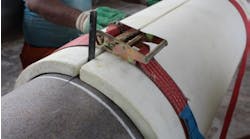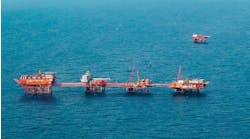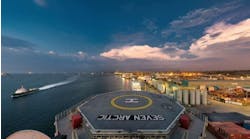Well servicing, installation vessel designed for host of subsea tasks
Model of the proposed multipurpose column-stabilized vessel.As deepwater developments proliferate, more specialized workover vessels will be needed to service the remoter subsea wells. No such vessels operate off West Africa currently, but they will be essential should production hit 1,300 meters water depth, as predicted shortly.
French conceptual engineers have been influential in this region lately, and Seamet International/Chantiers de l'Atlantique hope to join that list. With funding from France's Oil & Gas Ministry, they have developed a new concept for managing all facets of subsea construction and maintenance, known as the Multipurpose Column Stabilized Vessel (MCSV).
Sevres-based Seamet has many years' experience working on drilling and production concepts, including a column-stabilized production platform that was considered for the Snohvit Field development off northern Norway. The new MCSV would be most analogous to the Uncle John, says Seamet's Andre Rey-Grange, "but with better performance". Off West Africa, the concept might best suit (for reasons of economics) a group of fields implementing subsea technology.
Oil companies and drilling contractors such as Sedco Forex have been briefed on the MCSV, which would preferably be built at the Chantiers yard in St Nazaire on France's west coast. Chantiers is anxious to get back into the oil and gas construction industry after some time out. However, through a license agreement, the MCSV could also be constructed in other shipyards.
Vessel description
The twin-hulled MCSV measures 95 meters long and 62.6m wide, with six supporting columns, each 22.7m high. Cellar deck area is 21 x 39m, with an upper deck of 71 x 53.6m. Total deck load sustained above the upper deck would be 2,000 tons.In transit, the self-propelled vessel would cruise at 12 knots in seastate 3, with displacement of 13,000t (rising to 20,000t in operation). Dynamic positioning allows the MCSV to maintain station in winds up to Force 8, even during drilling, providing an unusually stable work platform. As the propellers and thrusters do not protrude below the lower hull, the vessel could also move around in shallow waters.
A wide range of tasks are envisaged. The main ones are:
- carrying facilities from shore to location, installing subsea templates and modules
- performing all completion tasks on previously drilled wells, including stimulation and testing
- installing subsea flowlines and control lines between satellite wells and underwater manifold centers
- maintenance and workover operations on subsea production wells, from wireline work through to recompletion
- installing large anchor piles for FPSOs, tanker loading facilities
- repair of subsea equipment and pipelines and performing inspection duties using divers or ROVs
- seabottom soil surveys via core holes or penetrometer tests.
Adjacent to the workover rig, a service and repair area for subsea equipment includes a 100t hookload capacity overhead crane. The workover rig features a power swivel, with a mechanical pipe handling system in the derrick and on the top deck. The mud system can handle multiple batches of speciality well fluids and is equipped with high pressure pumps.
Elsewhere on the MCSV, there are spaces for an observation ROV, a deep-diving system, electric logging and mud logging units. Well-test facilities include a heater, separator, meters and burner. Up to 120 people can be accommodated.
Athough no firm interest has been expressed in the MCSV, Seamet is aware that Elf will need such a unit for a prospective project offshore Angola, and will encourage contractors to make the investment.
Last year Seamet also performed extensive R&D for Elf for multi-function barges operating in West African deep waters. This included a conceptual and basic design of a surface wellbay to house 30 wellheads, which would therefore be easily accessible to drilling and servicing rigs.
Copyright 1997 Oil & Gas Journal. All Rights Reserved.


